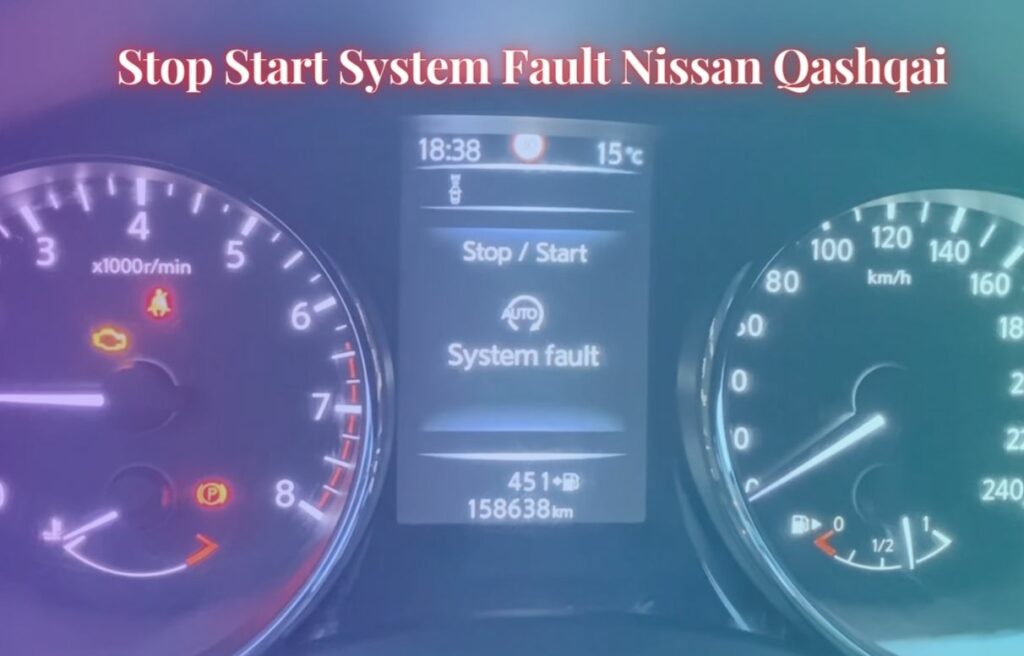
In our garage, I have encountered many Nissan Qashqai owners who have experienced issues with their stop-start system. This system was designed to save fuel by shutting off the engine when it is not needed, and it is activated when the car has been stopped for more than three seconds. However, it seems to be a common problem that many Nissan Qashqai owners face.
Fortunately, in my experience, this issue can be resolved easily. In this article, I will share my knowledge and offer some practical advice on the main causes and how to repair a stop-start system in a Nissan Qashqai. What is Nissan Qashqai Stop-Start Feature?
What Does Qashqai’s “Stop Start System Fault” Mean?
If you see the “Stop/Start System Fault” message on your Qashqai, it means the car’s ECU has detected an issue with the Stop/Start system. This system automatically stops and starts the engine when the car is stationary. When the fault occurs, the car won’t be able to perform this function.
What Causes Nissan Qashqai “Start Stop System Fault”?
The Stop-Start System Fault in Nissan Qashqai is a common issue that can be caused by a variety of factors including age expired battery, faulty alternator or some sensor issue. However, the number one cause of this issue is a bad or failing battery.
How to Fix Nissan Qashqai Stop Start System Fault
Usually this problem could be solved 99% if you change the main battery. In some rare cases replacing the battery won’t solve the issue. I will discuss all the possible solution here.
Solution 1: Check and Replace Main Battery
The battery plays a crucial role in the operation of the stop-start system, providing the necessary power to quickly restart the engine when needed. If the battery is weak or damaged, it may not be able to deliver the required current, leading to SSS malfunctions. Therefore, it’s essential to check the battery’s condition regularly, especially if the vehicle is experiencing cold starts or has been sitting unused for extended periods.
To assess battery health, consider the following:
- Battery Age: A car battery typically lasts around 3-5 years, depending on factors like driving habits and climate conditions. If your battery is approaching or has exceeded its lifespan, it’s advisable to have it tested or replaced. The car company also suggest to replace the battery after 3-5 years.
- Cold Cranking Amps (CCA): CCA is a measure of a battery’s ability to provide power at low temperatures. If the CCA rating is too low, it may struggle to handle the demands of the stop-start system, especially in colder climates. Consult your Nissan Qashqai’s owner’s manual for the recommended CCA rating for your vehicle.
- Battery Voltage: A fully charged battery should maintain a voltage of around 12.6 volts. If the voltage is consistently low, it indicates that the battery is not holding a charge properly and may need replacement.
If your battery is weak or old, replacing it with a high-quality battery that meets the manufacturer’s specifications can resolve the SSS issue.
Solution 2: Disconnect and Reconnect the Positive Battery Terminal
Sometimes, a simple reset of the ECU (engine control unit) can resolve minor glitches or temporary issues that may be causing the stop-start system fault. Disconnecting the positive battery terminal for about 20 seconds will temporarily cut power to the ECU, forcing it to restart and clear any pending fault codes.
To perform this reset, ensure the vehicle is completely turned off and parked in a safe location. Disconnect the positive battery terminal using a wrench or socket. Wait for 20 seconds, then reconnect the positive terminal. Start the engine and check if the warning light has disappeared.
Solution 3: Use Injector Cleaner (as a last resort)
In some rare cases, accumulated deposits or buildup in the fuel injectors can affect engine performance and potentially lead to stop-start system malfunctions. Using an injector cleaner can help remove these deposits and improve fuel combustion efficiency.
However, it’s important to note that using injector cleaner should be considered a last resort after addressing potential battery or electrical issues. If the warning light persists after trying the above solutions, consult with Nissan dealer for a more thorough diagnosis.
⚠️ Common Dash Warning on Nissan Qashqai:
|| Learn about other Qashqai faults before they happen
Additional Considerations:
- Alternator Check: The alternator is responsible for charging the battery while the engine is running. If the alternator is not generating enough power, the battery may not be able to maintain a sufficient charge, leading to SSS malfunctions. You can ask your nearby mechanic to check the alternator’s output to ensure it is functioning properly.
- Sensor Check: Faulty sensors can provide incorrect information to the ECU, disrupting the operation of the stop-start system. Take your car to the reputed garage, they can inspect various sensors, such as the clutch position sensor, battery voltage sensor, and engine temperature sensor, to identify any faults and make necessary replacements.
- Electrical System Check: Loose connections, corrosion, or other electrical problems can also interfere with the stop-start system. A thorough inspection of the electrical system can reveal any underlying issues that need to be addressed.
Can You Drive with a “Start Stop System Fault” on a Qashqai?
Yes, you can still drive with a “Start Stop System Fault” on a Qashqai, as long as there are no other faults in the vehicle. The system is not directly related to how the engine works, so it won’t cause any damage to your car.
However, it is recommended that you get the issue sorted out as soon as possible to save gas when idling. According to the Nissan Qashqai Guide, a bad/failing battery is the number one cause of the start-stop system fault.
Therefore, it is important to check your battery regularly and replace it as needed, as recommended by Wolfchase Nissan.

Leave a Reply